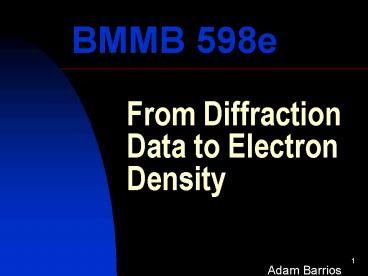From Diffraction Data to Electron Density - PowerPoint PPT Presentation
1 / 14
Title:
From Diffraction Data to Electron Density
Description:
Because F(h) and f(x) are on opposite sides of the integral their units are ... Allows crystallographers to deduce information about real space p(x,y,z) ... – PowerPoint PPT presentation
Number of Views:74
Avg rating:3.0/5.0
Title: From Diffraction Data to Electron Density
1
From Diffraction Data to Electron Density
BMMB 598e
- Adam Barrios
2
Diffraction Pattern
Electron Density
3
- X-Ray ? Object ? Diffraction Pattern
When we look at a picture our mind can take a 2
dimension image and turn it into 3
dimensions Our minds do the same thing to a
picture that a Fourier Transform does to a
diffraction pattern The goal is a 3 dimensional
electron density map
4
- Closer Examination of a Fourier Transform
Goal convert p(h,k,l) to p(x,y,z) Break down
the Fourier Transform into its simplest
terms Fourier Series the sum of all the simple
waves
f(X)Vertical height FAmplitude Hfrequency
5
- Add up Fourier Terms to get a Fourier Series
Basic Waveform
From complex number theory the Fourier series
becomes
6
- Problem.
? Deals with a one dimensional wave, f(x)
To expand our model to include three dimensions
we need to account for a wave function in each of
the three dimensions (x,y,z) we give these terms
the names (h,k,l)
7
- Exploring the Fourier Transform
First take the single wave function
Integrate with respect to (h)
?Where F(h) is the Fourier Transform
Because F(h) and f(x) are on opposite sides of
the integral their units are reciprocal of one
another This ties real space and reciprocal space
together
8
- This equation is for a single dimension
We need to add two more dimensions
- Allows crystallographers to deduce information
about real space p(x,y,z) - Lead to information about contents of unit cell
9
A look at Structure Factors
- A single structure factor describes one
diffracted x-ray, one reflection - Can be written as a Fourier series for one atom
giving the reflection (h,k,l)
fj is the mathematical term describing the
electron density surrounding atom j
10
For a unit cell with n atoms the diffraction
pattern becomes more complicated
This equation takes into account the contribution
of each atom to the diffraction pattern
So what happens if we change the volume used to
calculate our electron density?
11
Assigning specific volumes to calculate Electron
Density
The smaller we make our volume unit the closer we
come to the actual values, electron density at a
specific location
We attempt to do this to pinpoint p(x,y,z)
In English F(h,k,l) is the transform of
p(x,y,z) In other words all the F(h,k,l)s
together form the transform of p(x,y,z) on all
sets of equivalent planes throughout the unit cell
12
Since p(x,y,z) is electron density we can
rearrange the previous equation to get electron
density as the transform of structure factors
Where Fhkl is the term for structure factors
We dont use the integral function because Fhkl
is a set of discrete entities
We use a Fourier series for structure factors
because structure factors describe diffracted
rays that produce the reflections
13
Other Key Points
This equation only describes low frequency terms
but it is the high frequency terms (reflections
farthest from center) that give us the high
resolution
To compute structure factors the intensity of
each reflection is needed
Luckily the square root of Intensity (from
diffraction data) is proportional to the
amplitude of its structure factor
14
Is that it?
Of course not, we still need to consider the
phase of the structure factor
But we will save that for next time!































